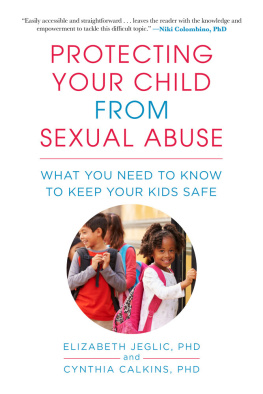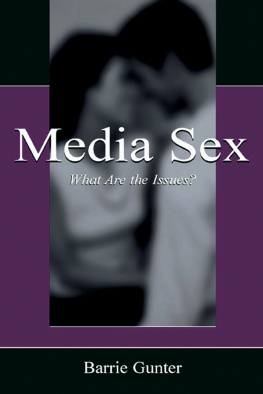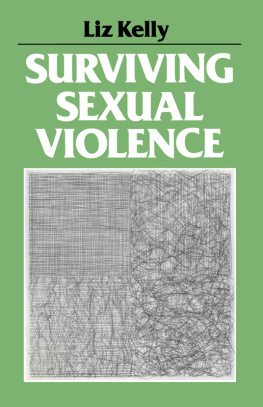First published 2004 by Pluto Press
345 Archway Road, London N6 5AA
and 839 Greene Street, Ann Arbor, MI 48106
www.plutobooks.com
Copyright Jenny Kitzinger 2004
The right of Jenny Kitzinger to be identified as the author of this work has been asserted by her in accordance with the Copyright, Designs and Patents Act 1988.
British Library Cataloguing in Publication Data
A catalogue record for this book is available from the British Library
ISBN 0 7453 2332 4 hardback
ISBN 0 7453 2331 6 paperback
ISBN 978 1 7837 1563 3 ePub
ISBN 978 1 7837 1564 0 Kindle
Library of Congress Cataloging in Publication Data applied for
10 9 8 7 6 5 4 3 2 1
Designed and produced for Pluto Press by
Chase Publishing Services, Fortescue, Sidmouth, EX10 9QG, England
Typeset from disk by Stanford DTP Services, Northampton, England
Printed and bound in the European Union by
Antony Rowe Ltd, Chippenham and Eastbourne, England
Acknowledgements
I would like to thank everyone who gave their time to my research projects and were prepared to talk to me so openly. I also wish to acknowledge financial support from the Economic and Social Research Council (award no. 000233657). The collection of most of the original data presented in this volume would not have been possible without such funds. I am grateful to former colleagues at Glasgow and my current colleagues at the Cardiff School of Journalism, Media and Cultural Studies for their intellectual engagement in developing the ideas presented here. As always thank you also to my family and friends whose forebearance and support throughout the preparation of this volume have been invaluable. Special thanks to Diana, Martha and Sarah whose love and encouragement sustained me through difficult times.
Above all, this book would not have been possible without all those who have campaigned to challenge sexual violence. I am particularly indebted to the young women in the Cambridge Incest Survivors refuge during the 1980s. It was their courage in speaking out about their abuse, and their request for information about other survivors experiences, that first set me on the journey which has culminated in this book so many years later.
Introduction
We live in a media saturated society. What does this mean for how we make sense of the world around us? How do the facts, stories, images and ideas presented in the mass media relate to our common-sense knowledge and critical judgements? What rhetorical strategies do journalists and their sources use to persuade people of their point of view? How do we respond to what we are told and come to our own conclusions? This book examines the mass medias role in defining, and sometimes transforming, social issues and influencing the way we think. It focuses on the medias role in relation to one of the major social problems of our time, child sexual abuse. The book combines analysis of media coverage with interviews with survivors of childhood sexual abuse and with journalists and their sources. In addition it presents a detailed analysis of 79 focus group discussions exploring peoples assumptions and fears about sexual abuse, their opinions about controversial cases, and how they relate media representations to their own experience. This unique dataset permits an examination of the significance of media content and production processes and an examination of both the extent and the limits of media influence over time. The findings from this research engage with, but also challenge, many of the contemporary debates about audience reception processes and media power.
THE RESEARCH THAT INFORMS THIS BOOK
My work in this field stretches back over 20 years and evolved in parallel with commitments both within and outside the field of media studies. Like any research it is informed by the social, political and disciplinary context in which it was conducted. This introduction outlines the diverse research initiatives that inform this volume, provides a sense of the context in which each research project was carried out, and guides the reader through the books structure.
I first started studying sexual abuse as a result of my involvement in the Womens Liberation Movement. One of the key aims of this movement was to challenge violence against women and children, Before the rise of second wave feminism, these acts of violence were often not taken seriously. Wife battering was dismissed as a domestic dispute, rape in marriage was not a criminal offence and child sexual abuse within the family was hardly acknowledged as a problem at all. During the 1970s, for example, headline news was attracted by the occasional child abduction, rape or murder, but discussion of the broader category of sexual exploitation of children in all its forms was largely taboo. There were also very limited services available for those enduring such abuse.
In the early 1980s I was part of a feminist collective in Cambridge, England, which set up a helpline and subsequently a refuge for sexually abused girls. The young women who contacted us needed accommodation and emotional support; they also desperately wanted images that reflected the reality of their own lives and they wanted to learn about other survivors experiences. At the time there were not many books on this subject. returning to these interviews now, they offer vivid testimony to the role of the media in cultural transformation.
In 1988 I moved to join the Glasgow University Media Group. This research group was already well known for its work on media bias, e.g. Bad News (1976) and More Bad News (1980). Some of the Glasgow team were now interested in looking at audiences too and I joined the group to work on a project examining the media coverage of AIDS and its impact on public understandings of the epidemic (see Kitzinger 1990; Miller et al. 1998). This was my first initiation into media studies as a discipline. I began to learn about the theoretical disputes and methodological issues involved in studying audiences and to integrate this with my previous training and research. Before moving to Glasgow I had been based in the Department of Social and Political Sciences at Cambridge, examining hospital staffing structures and experiences of hospital care. In this research I had looked at people as citizens, as embodied beings and as people negotiating structured power relations (collegial and doctorpatient). Prior to that I had graduated in social anthropology through which I had been taught to approach people as bearers of culture, performers of ritual and members of kinship groups. Moving to Glasgow introduced me to a novel set of questions about audiencetext relations and allowed me to combine media studies traditions with the approaches with which I was already familiar from other disciplines.
Using this cumulative experience I subsequently returned to my concerns about sexual violence. In 1992 the Economic and Social Research Council gave me a grant to study the role of media in covering child sexual abuse. This project involved three strands: first, interviews with journalists and their sources (e.g. the experts cited in the media), second, analysis of a whole years media coverage and third, focus group discussions with ordinary people to explore their responses. They were also asked to reflect on why they believed what they did and to think about anything that had made them change their minds. In addition I invited research participants to comment on the media coverage of child sexual abuse in general and to discuss one news story in particular. The story selected for detailed examination was a scandal involving disputed allegations of sexual abuse (the Orkney case). The groups were given a set of still photographs taken from the television coverage and invited to try to reproduce a typical news bulletin. They were then asked to reflect on this process, comparing the story they had produced with what they believed actually had happened. This task encourages people to engage actively in producing meaning and to deconstruct media reporting. Working with the photographs also helps the discussion to address the visual aspects of coverage as well as focusing on what has been said.







